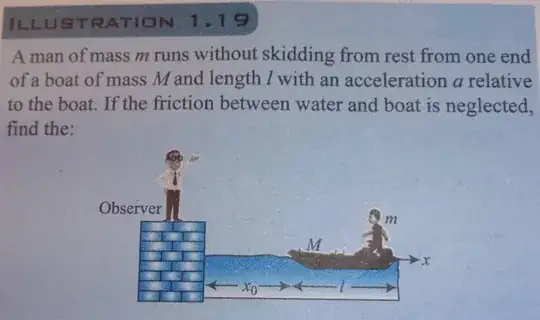As I am seeing this, the man and boat will have different displacement
from ground frame, so there should be a net work done by friction
Viewed from the ground frame (frame of the observer in picture) and considering the man alone as the system, the static friction force between the man and the boat does work on the man causing a horizontal displacement the man toward the observer. Per Newton's third law, the man exerts and equal and opposite external force on the boat that does work on the boat causing a horizontal displacement of the boat away from the observer.
The books says, total work done by friction is zero when friction is
static and internal to system. Please explain..
When the man and the boat are considered to be a system, the static friction force is internal to the system. Given there is no friction between the boat and water (and assuming no air friction as well) then there are is no net external force acting on the system and therefore no net work is done on the system by the internal static friction force. To put it another way, there is no displacement of the center of mass of the man/boat system due to the static friction force.
Can you mathematically show friction work adding up to zero.
Keep in mind we need to differentiate between friction work that is done on the man and the boat individually in the reference frame of the observer vs the friction work that is done on the system of the man + boat in the reference frame of the observer.
In the first case we apply Newton's second law to the boat and man individually and calculate the work done on each by the friction force.
In the second case we need to apply Newton's second law to the combination of the boat and man. The acceleration of the boat/man system is the acceleration of the center of mass of the boat/man system. Since the boat and man will each accelerate with an acceleration inversely proportional their masses, the acceleration of the center of mass of the boat and man will be
$$a_{cm}=\frac{Ma_{M}+ma_{m}}{M+m}$$
Per Newton's third law, the friction force exerted on the man by the boat is equal and opposite to the friction force exerted by the man on the boat, or
$$Ma_{M}=-ma_{m}$$
Consequently, $a_{cm}=0$. Therefore there is no displacement of the center of mass of the boat/man system. The internal static friction force does no net work on the boat/man system.
Now, in response to your discussions with @Adrian Howard:
So am I correct to say that, in ground frame, the kinetic energy is
due to internal friction forces. I am just trying to apply work energy theorem..
The net (static friction) force on the man equals its change in kinetic energy in the observers reference frame and equals the change in kinetic energy of the boat in the observers reference frame.
Also I read that, work done by non-conservative forces changes
mechanical energy of system. So what I am thinking is that friction
being internal nonconservative force, added kinetic energy to this
system(in ground frame). Point me where I am wrong, or is it a correct
explanation.
Static friction does add kinetic energy to the boat and man individually, but it does not add kinetic energy to the center of mass of the boat/man system, since there is no change in velocity of the center of mass of the system. For the boat/man system the total change in kinetic energy, at the macroscopic level, is the sum of the changes in its internal kinetic energy (man plus boat individually) and external kinetic energy (kinetic energy of the center of mass of boat/man system). The change in kinetic energy of the center of mass is zero.
In your example of the system of charges, the increase in kinetic energy of the charges accelerating towards each other involves an equal decrease in electrical potential energy. Total mechanical energy is conserved because the electrical force are conservative. For the boat/man system there is an increase in internal kinetic energy of the system with no change in potential energy. Mechanical energy is not conserved because friction forces are non-conservative. The increase in kinetic energy comes from the internal energy of the man (chemical energy).
But for both the boat/man system and system of charges there is no change in kinetic energy of the center of mass of either system, because there is no net external force acting on either system.
Hope this helps.
